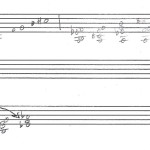I’m a big fan of ambient knowledge.
In the course of my various pursuits, both musical and non-, I occasionally find it necessary to re-look-up terms and concepts that I learned a long time ago — things I’m sure I know, but which are momentarily beyond my mental grasp, due, I believe, to a combination of The Law of Accelerating Returns as it applies to what I need to know, and the socio-ecogenic ADHD with which I am afflicted.
(And if the sentence above weren’t a description of my real life, I would enter it in The Bulwer-Lytton Fiction Contest!)
Case in point: while writing my previous post, I needed to refresh my memory of how to refer to specific musical pitches using a letter name and a number, such that it’s clear exactly which octave you’re talking about. For example, middle C on the piano is labeled ‘C4’, not to be confused with ‘C3’, which is an octave lower. It’s called scientific pitch notation, evidently — I’d never heard the official name of the system before. But it’s more concise and precise than saying, “the G an octave-and-a-half below middle C,” when you can just say, “G2,” and know that you’ll be understood (by other music nerds, at least 😉 ).
The Wikipedia article linked above also contained the following juicy little tidbit:
Scientific pitch notation is a logarithmic frequency scale. Although pitch notation is intended to describe audible sounds, it can also be used to specify the frequency of non-audible phenomena. For example, when the Chandra X-ray Observatory observed pressure fronts propagating away from a black hole, the frequency of the waves was reported in the press as the B♭ 57 octaves below middle C, or B♭−53, corresponding to one oscillation every 10 million years.”
Whoa, talk about your nerdy examples! That’s some far-out cosmic instrument, btw — I thought I had spent some long hours in the practice room, but 10 million years?!?
Now, I know that you can’t believe everything you read on Wikipedia, so I searched around for other sources for that wacky little factoid. I found one that has a title I envy immensely: I Know Why the Black Hole Sings.
Turns out, the universe is one vast Mighty Wurlitzer! Awesome! 😀





“Basso Molto Profundo” reminded me of the work of an astrophysicist at the University of Virginia. He translates the sound of the Big Bang by transposing the detectable waves up 50 octaves to humanly audible sounds. It is really quite amazing. Check it out at http://www.astro.virginia.edu/~dmw8f/BBA_web/index_frames.html. Is that basso molto profundo or what?